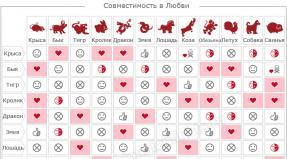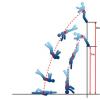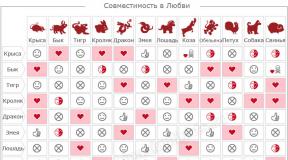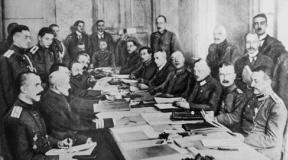Thresholds of the afterlife. Thresholds of the afterlife Who transported the dead across the River Styx
For centuries, man, realizing the inevitability of death, wondered: what awaits him beyond the borders of life? It would seem that world religions, such as Islam and Christianity, satisfied this curiosity a long time ago, promising sinners the torment of hell, and the righteous a carefree life in heaven.
However, according to ancient sources, thousands of years ago people believed in a completely different afterlife, promising the deceased exciting adventures, a fun break from earthly worries and even... a chance to return to the world of the living. But getting to the kingdom of shadows was sometimes not easy.
Important profession - carrier
We all know well from history textbooks that ancient peoples were very sensitive to funeral rites. It could not be otherwise, because according to many religions, in order to reach the kingdom of shadows, the deceased had to overcome many obstacles. First of all, it was necessary to appease the carrier who was crossing the river separating the worlds of the living and the dead.
Almost all myths of different times and peoples mention this strange edge of the worlds in the form of a water barrier. Among the Slavs it is the Smorodinka River, among the ancient Greeks it is the Styx, and among the Celts it is the boundless sea, overcoming which the deceased will reach a beautiful island - the Land of Women.
It is not surprising that the character who transported the souls of the dead on his boat enjoyed special respect. Thus, in Ancient Egypt it was believed that even a person buried according to all the rules would not be able to reach the afterlife land of eternal happiness, the Fields of Nala, if he did not appease a certain nameless old man - a ferryman who transported the dead across the river.
Therefore, caring relatives placed special amulets in the sarcophagus of the deceased, which later served as payment for passage in the old man’s boat.
In Scandinavian legends, the worlds of the living and the dead are separated by a terrible deep river with dark water, the banks of which are connected only in one place by a golden bridge. It is very difficult to pass it, since ferocious packs of wild dogs prowl the crossing, and a crowd of evil giants guards it.
But if the spirit of the deceased is able to come to an agreement with the mother of the giants, the witch Modgud, then he will have no problems on the way to the kingdom of the dead. But the warriors who distinguished themselves and fell in battle are met on the golden bridge by Odin himself - it is the lord of the gods who accompanies the heroes to Valhalla (a special place in the world of the dead), where an eternal feast awaits them in the company of beautiful Valkyries.
The most severe carrier of the souls of the dead was Charon, the hero of ancient Greek myths. It was impossible to come to an agreement with this old man, who transported the shadows of the deceased to the kingdom of Hades across the River Styx, since Charon sacredly observed the laws established by the Olympian gods.
For passage in his boat, both from the great king and from the insignificant slave, Charon took only one obol (small copper coin), which the relatives put in the mouth of the deceased during burial. However, getting into the boat of this carrier was not easy - only the deceased, buried according to the proper rules, could count on the crossing.
If the relatives of the deceased were stingy with sumptuous sacrifices to the gods of Hades, Charon drove him away without any pity, and the poor fellow was doomed to eternal wandering between worlds.
The Path to the Land of Women
However, the most tempting afterlife awaited the ancient Celts. Many legends have been preserved about unknown islands, where a truly heavenly and not at all boring life awaited the dead. On the island, which in legend was called the Land of Women, everyone could choose an activity to suit their taste.
So, brilliant tournaments were held there for brave warriors, ladies enjoyed the company of sweet-voiced minstrels, drinkers rejoiced at the rivers of ale... But wise rulers and druids did not stay in this paradise, since soon after death they were faced with the next incarnation - after all, their intelligence was needed for future generations.
 It is not surprising that for several centuries the Celtic warriors were considered the most fearless and desperate fighters - you don’t have to value life if such a wonderful island awaits you on its doorstep.
It is not surprising that for several centuries the Celtic warriors were considered the most fearless and desperate fighters - you don’t have to value life if such a wonderful island awaits you on its doorstep.
True, getting to the Land of Women was not easy. Legend has it that a thousand years ago there was a mysterious village on the western coast of Brittany. The inhabitants of this village were exempted from all taxes, since the men of the village were burdened with the difficult task of transporting the dead to the island.
Every midnight, the villagers woke up from loud knocking on their doors and windows and went to the sea, where strange boats, shrouded in a light fog, were waiting for them. These boats seemed empty, but each of them was submerged in water almost to the very side. The carriers sat down at the helm, and the canoes began to glide across the sea surface on their own.
Exactly an hour later, the bows of the boats touched the sandy shore, where unknown guides in dark cloaks were waiting for the arrivals. Those greeting them announced the names, rank and family of those who had arrived, and the boats quickly emptied. This was indicated by the fact that their sides rose high above the water, indicating to the carriers that they got rid of the mysterious passengers.
Guards at the threshold
In many ancient religions, the guardians of the thresholds of the afterlife are... dogs, which not only guard the kingdoms of the dead, but also protect the souls of the deceased.
 The ancient Egyptians believed that Anubis, the jackal-headed god, ruled the world of the dead. It is he who meets the soul that has descended from the carrier's boat, accompanies it to the court of Osiris and is present at the sentencing.
The ancient Egyptians believed that Anubis, the jackal-headed god, ruled the world of the dead. It is he who meets the soul that has descended from the carrier's boat, accompanies it to the court of Osiris and is present at the sentencing.
According to Egyptian myths, Anubis taught people how to mummify corpses and the true burial ritual, thanks to which the dead would have a decent life in his domain.
Among the Slavs, those who died were escorted to the next world by a gray wolf, who later became famous thanks to Russian fairy tales. He transported the deceased across the legendary Smorodinka River, while instructing his riders on how to behave correctly in the kingdom of Rule. According to Slavic legends, the gates of this kingdom were guarded by the huge winged dog Semargl, under the protection of which were the borders between the worlds of Navi, Reveal and Prav.
However, the most ferocious and unforgiving guardian of the world of the dead is the creepy three-headed dog Cerberus, repeatedly sung in the myths of the ancient Greeks. Legends say that the ruler of the kingdom of the dead, Hades, once complained to his brother Zeus that his possessions did not have proper protection.
The domain of the lord of the dead is gloomy and joyless and has many exits to the upper world, which is why the shadows of the dead will soon emerge into the white light, thereby disrupting the eternal order. Zeus listened to his brother’s arguments and gave him a huge dog, whose saliva was a deadly poison, and whose body was decorated with hissing snakes. Even Cerberus’s tail was replaced by a poisonous, terrible snake.
For many centuries, Cerberus carried out his service impeccably, not allowing the shadows of the dead to even approach the borders of the kingdom of Hades. And only once did the dog briefly leave his post, as he was defeated by Hercules and taken to King Ephriseus as confirmation of the twelfth labor of the great hero.
Nav, Reality, Rule and Glory
 Unlike other peoples, the Slavs believed that the presence of the soul in the world of the dead is temporary, since the deceased will soon be reborn among the living - in the kingdom of Revealing.
Unlike other peoples, the Slavs believed that the presence of the soul in the world of the dead is temporary, since the deceased will soon be reborn among the living - in the kingdom of Revealing.
Souls, not burdened by crimes, having passed the boundaries of the worlds, found temporary refuge among the gods in the kingdom of Rule, where they prepared for rebirth in bliss and peace.
People who died in battle were transported to the world of Slavi. There, Perun himself met the heroes and invited the brave men to settle forever in their possessions - to spend an eternity in feasts and entertainment.
But the dark kingdom of Navi awaited sinners and criminals, where their souls froze in a centuries-long heavy sleep, and only relatives who remained in the world of Reveal could disenchant (pray) them.
A deceased person who had rested in the kingdom of Prav after some time reappeared among the living, but always in his own family. The Slavs believed that, as a rule, two generations passed from the moment of death to the moment of birth, that is, the deceased person was incarnated in his great-grandchildren. If the clan was interrupted for some reason, then all its souls were forced to reincarnate into animals.
The same fate awaited irresponsible people who abandoned their families, children who did not respect their elders. Even if the family of such apostates grew strong and prosperous, they still could no longer count on a dignified rebirth.
Children whose parents stained themselves with the sin of adultery also suffered a similar punishment. With this in mind, the husband and wife did not even look at each other until their youngest child turned 24 years old, which is why Slavic marriages were strong and friendly.
Elena LYAKINA
In cases where the river blocked the entrance to afterworld, the soul of the deceased could cross its waters in several ways: by swimming, crossing on a canoe, crossing a bridge, crossing with the help of an animal, or on the shoulders of a deity. It seems that the oldest way to cross a real and not too deep river was to ford it. In this case, it is most likely that young and strong men carried children, sick and weak people on themselves so that they would not be carried away by the current. Perhaps this ancient method of crossing formed the basis of the saga of Thor, who carried Orvandill the Bold across the “noisy waters.” This plot was later reworked in the Christian spirit and became known as the story of St. Christopher, i.e. the bearer of Christ. Briefly this story is this.
A giant named Oferush was engaged in carrying wanderers on himself through a stormy and swift stream, “in the depths of which everyone who wanted to drown drowned.” cross to the other side." One day, at the request of the child-Christ, he began to carry him on his shoulders through a seething stream and felt an incredible weight on his shoulders. Turning to the child, the giant asked in fear why it was so hard for him, as if he had lifted a whole world. “You raised the one who created the world!” the child answered him. “Western peoples represent St. Christopher as a giant with a terrible face and the same red hair that Thor had... Eastern legends give St. Christopher with a dog's head, with which he was depicted on ancient icons. cannot swim across, and not one of the dead can overcome, in order to return to the living, both the ferryman and the guardian of this river, carrying souls to the other side.
It was imagined that the river, bridge or entrance to the afterlife was guarded, and the guards were either anthropomorphic creatures or animals. In Nganasan mythology, the souls of the dead are transported independently - by swimming. And no one guards the approaches to the village of the dead. The Orochi made a coffin from an old boat, and the Khanty buried their dead in a boat sawn crosswise: one part served as a coffin, the other as a lid. The image of a man sitting in a fishing boat without oars meant being sent to the lower world. It is interesting that in Manchu mythology the spirit Dokhoolo age (“lame brother”), one-eyed and crooked-nosed, on half a boat ferries the souls of the dead across the river to the kingdom of the dead, rowing with half an oar. This deterioration of the body and the half-heartedness of the craft indicate that the carrier himself was a dead man. Perhaps Manchu mythology retained the ancient idea of the carrier himself as deceased.
In other mythological systems, this role is played by a person without external signs of involvement in the other world, except that the slovenly and senile appearance of Charon, or the backward head of the Egyptian ferryman, make it possible to make a similar assumption. However, in the mythological representations of the Nganasans, Orochs and Khanty, guards of the underworld do not appear. The Evenks allow the soul of the deceased to enter the afterlife buni depended on his mistress: on her orders, one of the dead got into a birch bark boat and sailed to the opposite shore to pick up the soul and transport it to buni. No special carrier, no guard. But in the mythological ideas of the Evenks, the river connecting all three worlds had an owner, its owner and guardian - kalir. a giant moose with antlers and a fish tail, although it did not play any role in the crossing to the afterlife.
In the mythological ideas of other peoples, “specialization” is already noticeable: the motive of owning a boat indicates that the image of a carrier to the afterlife was based on the idea of real-life people, whose job was to transport people across the river. So the “afterlife” boat had an owner, and when people learned to build bridges, the idea of an owner and guardian of the bridge arose. It is possible that it arose from the fact that initially, perhaps, a fee similar to that charged for transportation was charged for crossing the bridge.
Among the Mansi, such a carrier was considered to be the god of the underworld himself - Kul-Otyr, from touching whose black fur coat a person fell ill and died. In Sumerian-Akkadian mythology, there was an idea of the unburied souls of the dead returning to earth and bringing misfortune. The souls of the buried dead were transported across the “river that separates people from people” and is the border between the world of the living and the world of the dead. Souls were transported across the river on the boat of the carrier of the underworld Ur-Shanabi or the demon Khumut-Tabala. The carrier Ur-Shanabi was considered the consort of the goddess Nanshe, whose name spelling included the sign for fish. She was revered as a fortuneteller and interpreter of dreams. The Sumerians buried the deceased with a certain amount of silver, “which he had to give as payment for transportation to “the man on the other side of the river”.” (4)
In Finnish mythology, the role of the carrier across the river was played by the maiden Manala, in the German-Scandinavian maiden Modgug was the guardian of the bridge, in Iranian mythology - a beautiful girl with two dogs, met the deceased at the bridge and transferred him to the other side. (Videvdat, 19, 30). In later Zoroastrian texts, Sraosha, armed with a spear, mace and battle ax, met the soul of the deceased at the Chinvat bridge leading to the afterlife, and transferred it for a bribe of baked bread.
In Egyptian mythology, by sailing on a boat, the deceased pharaoh could reach the eastern part of the sky. “The deceased had to be transported by a special carrier, who in the Pyramid Texts is called “the one looking behind him.”(5) He was also called the “carrier of the reed field” - sekhet iaru, the desired place of residence of the gods in the east. However, the ancient Egyptians also had an idea about the afterlife, located in the west. The goddess of the west, that is, the kingdom of the dead, was Amentet. She extended her hands to the dead, welcoming them to the land of the dead. Almost the same name - Aminon - was borne by the guard of the bridge leading to the land of the dead in Ossetian mythology. She asked the dead what they did good and bad during their lifetime, and according to the answer, she showed them the path to hell or heaven.
Finally, in Greek mythology, Charon was the carrier of souls across the river and its guardian: “The waters of underground rivers are guarded by a terrible carrier - / Gloomy and formidable Charon. A scraggly gray beard / is overgrown all over his face - only his eyes burn motionless, / The cloak on his shoulders is tied in a knot and hangs ugly, / He drives the boat with a pole and steers the sails himself, / He transports the dead on a fragile canoe across a dark stream. / God is already old, but he retains vigorous strength even in old age.” (6) The carrier was to be paid, so a coin was placed in the dead man’s mouth. In Russian funeral rituals, money was thrown into the grave to pay for transportation. The Vepsians also did the same, throwing copper money into the grave, however, according to most informants, this was done to buy a place for the deceased. The Khanty threw several coins into the water, to the deities - the owners of the cape, noticeable rocks, stones past which they swam.
The Styx, the mythical river of the dead, is known not only for being a link between the world of the living and the otherworldly kingdom of Hades. A large number of myths and legends are associated with it. For example, Achilles received his strength when he was dipped in the Styx, Hephaestus came to its waters to temper Daphne’s sword, and some heroes swam across it while alive. What is the River Styx and what power do its waters have?
Styx in ancient Greek mythology
Ancient Greek myths tell us that Styx is the eldest daughter of Ocean and Tethys. Her husband was the Titan Pallant, with whom she had several children. Also, according to one version, Persephone was her daughter, born from Zeus.
Styx took the side of Zeus in his battle with Kronos, taking an active part in it. She made a significant contribution to the victory over the Titans, for which she received great honor and respect. Since then, the River Styx has become a symbol of a sacred oath, breaking which was considered unacceptable even for God. Anyone who violated an oath by the waters of the Styx was severely punished. However, Zeus was always favorable to Styx and her children because they always assisted him and were faithful.
River in the kingdom of the dead
What is the River Styx? The mythology of the ancient Greeks tells that there are places on earth where the sun never looks, so eternal darkness and gloom reign there. It is there that the entrance to the domain of Hades is located - Tartarus. Several rivers flow in the kingdom of the dead, but the darkest and most terrible of them is the Styx. The River of the Dead circles the kingdom of Hades nine times, and its waters are black and muddy.

According to legend, the Styx originates far in the west, where night reigns. Here is the luxurious palace of the goddess, the silver columns of which, which are streams of a source falling from a height, reach to the heavens. These places are uninhabited, and even the gods do not visit here. An exception can be considered Iris, who occasionally came to fetch the sacred water of the Styx, with the help of which the gods made their oaths. Here the waters of the source go underground, where horror and death live.
There is one legend that says that the Styx once flowed in the northern part of Arcadia, and Alexander the Great was poisoned with water taken from this river. Dante Alighieri in his “Divine Comedy” used the image of a river in one of the circles of hell, only there it appeared as a dirty swamp in which sinners will get stuck forever.
Carrier Charon
The crossing to the kingdom of the dead is guarded by Charon, the ferryman on the River Styx. In the myths of Ancient Greece, he is depicted as a gloomy old man with a long and unkempt beard, and his clothes are dirty and shabby. Charon's duties include transporting the souls of the dead across the River Styx, for which he has at his disposal a small boat and a single oar.

It was believed that Charon rejected the souls of those people whose bodies were not properly buried, so they were forced to wander forever in search of peace. Also in ancient times, there was a belief that you had to pay the ferryman Charon to cross the Styx. To do this, during burial, the relatives of the deceased placed a small coin in his mouth, which he could use in the underground kingdom of Hades. By the way, a similar tradition existed among many peoples of the world. The custom of putting money in the coffin is observed by some people to this day.
Analogues of Styx and Charon
The River Styx and its guardian Charon are quite characteristic images that describe the transition of the soul to another world. Having studied the mythology of different peoples, you can see similar examples in other beliefs. For example, among the ancient Egyptians, the duties of a guide to the afterlife, which also had its own river of the dead, were performed by the dog-headed Anubis, who led the soul of the deceased to the throne of Osiris. Anubis is very similar in appearance to a gray wolf, which, according to the beliefs of the Slavic peoples, also accompanied souls to the other world.

There were many legends and traditions in the ancient world, sometimes they may not correspond or even contradict each other. For example, according to some myths, the ferryman Charon transported souls not through the Styx, but through another river - the Acheron. There are also other versions regarding its origin and further role in mythology. Nevertheless, the River Styx today is the personification of the transition of souls from our world to the afterlife.
Rivers Aida Styx and Acheron. - Carrier Charon. - God Hades (Pluto) and goddess Persephone (Proserpina). - Judges of the kingdom of Hades Minos, Aeacus and Rhadamanthus. - Triple goddess Hecate. - Goddess Nemesis. - The Kingdom of the Dead by the ancient Greek artist Polygnotus. - Sisyphus' labor, Tantalus's torment, Ixion's wheel. - Barrel Danaid. - The myth of the Champs Elysees (Elysium).
Rivers Aida Styx and Acheron
According to the myths of ancient Greece, there were countries on the globe where eternal night reigned and the sun never rose over them. In such a country the ancient Greeks placed the entrance to Tartarus- the underground kingdom of the god Hades (Pluto), the kingdom of the dead in Greek mythology.
The kingdom of the god Hades was watered by two rivers: Acheron And Styx. The gods swore in the name of the River Styx, pronouncing oaths. Vows river Styx were considered inviolable and terrible.
The River Styx rolled its black waves through the silent valley and circled the kingdom of Hades nine times.
Carrier Charon
Acheron, a dirty and muddy river, was guarded by a ferryman Charon. The myths of ancient Greece describe Charon in this form: in dirty clothes, with an unkempt long white beard, Charon controls his boat with one oar, in which he carries the shadows of the dead, whose bodies are already buried on the ground; Those deprived of burial are mercilessly pushed away by Charon, and these shadows are condemned to wander forever, finding no peace (Virgil).
Ancient art so rarely depicted the ferryman Charon that the type of Charon became known only thanks to poets. But in the Middle Ages, the gloomy ferryman Charon appears on some monuments of art. Michelangelo placed Charon in his famous work "The Last Judgment", depicting Charon transporting sinners.
For transportation across the Acheron River, the carrier of souls had to be paid. This belief was so rooted among the ancient Greeks that they put a small Greek coin in the mouth of the dead. obol for payment to Charon. The ancient Greek writer Lucian mockingly notes: “It did not occur to people whether this coin was in use in the underworld of Hades, and they also did not realize that it would be better not to give this coin to the dead, because then Charon would not want to transport them, and they could return again to the living.”
As soon as the shadows of the dead were transported across Acheron, the dog Hades met them on the other side Cerberus(Kerberus), having three heads. The barking of Cerberus terrified the dead so much that it took away from them even any thought about the possibility of returning to where they came from.
God Hades (Pluto) and goddess Persephone (Proserpina)
Judges of the kingdom of Hades Minos, Aeacus and Rhadamanthus
Then the shadows of the dead had to appear before the god Hades (Pluto), the king of Tartarus, and the goddess Persephone (Proserpine), the wife of Hades. But the god Hades (Pluto) did not judge the dead; this was performed by the judges of Tartarus: Minos, Aeacus and Rhadamanthus. According to Plato, Aeacus judged Europeans, Rhadamanthus judged Asians (Radamanthus was always depicted in Asian costume), and Minos, by order of Zeus, was supposed to judge and decide dubious cases.
A perfectly preserved painting on one antique vase depicts the kingdom of Hades (Pluto). In the middle is the house of Hades. The god Hades himself, the lord of the underworld, sits on the throne, holding a scepter in his hand. Persephone (Proserpina) stands next to Hades with a lit torch in her hand. At the top, on both sides of the house of Hades, the righteous are depicted, and below: to the right - Minos, Aeacus and Rhadamanthus, to the left - Orpheus playing the lyre, below are sinners, among whom you can recognize Tantalus by his Phrygian clothes and Sisyphus by the rock he rolls
Triple Goddess Hecate
According to the myths of ancient Greece, the goddess Persephone (Proserpina) was not given an active role in the kingdom of Hades. The goddess of Tartarus, Hecate, called upon the goddesses of vengeance, the Furies (Eumenides), who captured and possessed sinners.
The goddess Hecate was the patroness of magic and spells. The goddess Hecate was depicted as three women joined together. This, as it were, allegorically explains that the power of the goddess Hecate extended to heaven, earth and the kingdom of Hades.
Initially, Hecate was not the goddess of Hades, but she gave Europe blush and thereby aroused the admiration and love of Zeus (Jupiter). The jealous goddess Hera (Juno) began to pursue Hecate. The goddess Hecate had to hide from Hera under her funeral clothes and thus became unclean. Zeus ordered the purification of the goddess Hecate in the waters of the Acheron River, and since then Hecate has become the goddess of Tartarus - the underground kingdom of Hades.
Goddess Nemesis
Nemesis, the goddess of retribution, played almost the same role in the kingdom of the god Hades as the goddess Hecate.
The goddess Nemesis was depicted with her arm bent at the elbow, which hinted at the elbow - a measure of length in antiquity: “I, Nemesis, hold the elbow. Why, you ask? Because I remind everyone not to go overboard."
The Kingdom of the Dead by the ancient Greek artist Polygnotus
The ancient Greek author Pausanias describes a painting by the artist Polygnotus depicting the kingdom of the dead: “First of all, you see the river Acheron. The banks of Acheron are covered with reeds; Fish are visible in the water, but these are more like shadows of fish than living fish. There is a boat on the river, and the ferryman Charon is rowing the boat. It is impossible to clearly distinguish who Charon is transporting. But not far from the boat, Polygnotus depicted the torture that a cruel son is subjected to who dares to raise his hand against his father: it consists in the fact that his own father is forever strangling him. Next to this sinner stands a wicked man who dared to plunder the temples of the gods; some woman mixes poisons, which he must drink forever, while experiencing terrible torment. In those days people revered and feared the gods; Therefore, the artist placed the wicked man in the kingdom of Hades as one of the most terrible sinners.”
Sisyphus' labor, Tantalus's torment, Ixion's wheel
Almost no images of the kingdom of the dead survived in the art of antiquity. Only from the descriptions of ancient poets do we know about some sinners and the torture they were subjected to in the kingdom of the dead for their crimes. For example,
- Ixion (Ixion wheel),
- Sisyphus (Work of Sisyphus),
- Tantalum (Tantalum flour),
- daughters of Danae - Danaids (barrel Danaids).
Ixion insulted the goddess Hera (Juno), for which in the kingdom of Hades he was tied by snakes to a wheel that was forever spinning ( Ixion wheel).
In the kingdom of Hades, the robber Sisyphus had to roll a huge rock to the top of a mountain, but as soon as the rock touched this peak, an invisible force threw it into the valley, and the unfortunate sinner Sisyphus, sweating profusely, had to begin his difficult, useless work again ( Sisyphus's work).
Tantalus, the king of Lydia, decided to test the omniscience of the gods. Tantalus invited the gods to a feast, killed his own son Pelops and prepared a dish from Pelops, thinking that the gods would not recognize what a terrible dish was in front of them. But only one goddess, Demeter (Ceres), depressed by grief due to the disappearance of her daughter Persephone (Proserpina), accidentally ate a piece of Pelops’ shoulder. Zeus (Jupiter) ordered the god Hermes (Mercury) to collect the pieces of Pelops, put them back together and revive the child, and make Pelops' missing shoulder out of ivory. Tantalus, for his cannibal feast, was sentenced in the kingdom of Hades to stand up to his neck in water, but as soon as Tantalus, tormented by thirst, wanted to drink, the water left him. Over the head of Tantalus in the kingdom of Hades hung branches with beautiful fruits, but as soon as Tantalus, hungry, stretched out his hand to them, they rose to heaven ( Tantalum flour).
Barrel Danaid
One of the most interesting tortures in the kingdom of Hades, which was invented by the rich imagination of the ancient Greeks, is the one to which the daughters of Danaus (Danaida) were subjected.
Two brothers, descendants of the unfortunate Io, Egypt and Danai, had: the first - fifty sons, and the second - fifty daughters. The dissatisfied and indignant people, incited by the sons of Egypt, forced Danae to retire to Argos, where he taught the people to dig wells, for which he was elected king. Soon the sons of his brother came to Argos. The sons of Egypt began to seek reconciliation with uncle Danai and wanted to take his daughters (Danaids) as wives. Danaus, seeing this as an opportunity to immediately take revenge on his enemies, agreed, but persuaded his daughters to kill their husbands on their wedding night.
All the Danaids, except one, Hypermnestra, carried out the orders of Danae, brought him the severed heads of their husbands and buried them in Lerna. For this crime, the Danaids were sentenced in Hades to forever pour water into a barrel that had no bottom.
It is believed that the myth about the barrel of Danaids seems to hint at the fact that the Danaids personify the rivers and springs of that country, which dry up there every summer. An ancient bas-relief that has survived to this day depicts the torture to which the Danaids are subjected.
The myth of the Champs Elysees (Elysium)
The opposite of the terrible kingdom of Hades is the Elysian Fields (Elysium), the seat of the sinless.
On the Champs Elysees (in Elysium), as described by the Roman poet Virgil, the forests are ever green, the fields are covered with luxurious harvests, the air is clean and transparent.
Some blissful shadows on the soft green grass of the Champs Elysees exercise their dexterity and strength in wrestling and games; others, rhythmically striking the ground with sticks, chant poetry.
Orpheus, playing the lyre in Elysium, extracts harmonious sounds from it. The shadows also lie under the canopy of laurel trees and listen to the cheerful murmur of the transparent springs of the Champs Elysees (Elysium). There, in these blissful places, there are the shadows of wounded warriors who fought for the fatherland, priests who maintained chastity throughout their lives, poets whom the god Apollo inspired, everyone who ennobled people through art, and those whose good deeds left a memory of themselves, and all they are crowned with the snow-white bandage of the sinless.

ZAUMNIK.RU, Egor A. Polikarpov - scientific editing, scientific proofreading, design, selection of illustrations, additions, explanations, translations from Latin and ancient Greek; all rights reserved.
Afterworld. Myths about the afterlife Petrukhin Vladimir Yakovlevich
Carrier of souls
Carrier of souls
The afterlife is located, as a rule, behind a body of water - a river or sea. Even the dead are delivered to the heavenly world by a heavenly boat, for example the boat of the Sun in Egyptian myths.
The most famous carrier to the next world is, of course, the Greek Charon. He retained his place even in Dante's Inferno. In the Greek myth and ritual, quite rationalized by the laws of the ancient polis (which regulated the funeral rite), Charon was supposed to pay for transportation with a coin (obol), which was placed under the tongue of the dead man. This custom has spread among many peoples of the world. Hermes, the messenger of the gods, who knew all the paths, was considered the guide of souls to the border of Hades.
Hermes calls the souls of Penelope's suitors, killed by Odysseus, from their bodies and, waving his magic golden rod - the caduceus, takes them to the underworld: the souls fly after him with a squeal. Hermes leads the souls of the suitors
...to the limits of fog and decay;
Past the Lefkada rock and the rushing waters of the ocean,
Past the gates of Helios, past the borders where the gods are
Dreams dwell, winnowed shadows on Asphodilon
A meadow where the souls of the departed fly in flocks of air.
Anyone who found himself at the Styx without money had to either wander along its gloomy shore or look for a bypass ford. Charon was also the guardian of Hades and transported across the Styx only those who were honored with proper burial rites.
The Styx borders Hades from the west, receiving the waters of the tributaries of the Acheron, Phlegethon, Cocytus, Aornitus and Lethe. The Styx, which means “hateful,” is a stream in Arcadia whose waters were considered deadly poisonous; Only later mythographers began to “place” him in Hades. Acheron - “stream of sadness” and Cocytus - “wailing” - these names are intended to show the ugliness of death. Lethe means "forgetfulness." Phlegethon - "blazing" - refers to the custom of cremation or the belief that sinners burn in lava flows.
Only the most powerful heroes - Hercules and Theseus - could force Charon to transport them alive to Hades. Aeneas was able to get there thanks to the fact that the prophetess Sibylla showed Charon a golden branch from the garden of the goddess of the underworld Persephone. She threw a lozenge containing sleeping pills to another guardian of the underworld, the monstrous dog Cerberus (Kerberus). Each deceased had to have a honey cake with him in order to distract this dog with three heads and a snake tail, whose entire body was also strewn with snakes. Cerberus, however, guarded not so much the entrance to the other world as the exit: he made sure that souls did not return to the world of the living.
Naturally, in the myths and rituals of a people separated from the mainland by sea - the Scandinavians - the motif of a funeral boat during the crossing to the next world is often found.
In the Saga of the Volsungs, the hero Sigmund, a descendant of Odin, takes the corpse of Sinfjötli’s son and wanders with him to God knows where until he comes to a fjord. There he meets a carrier with a small canoe. He asks if Sigmund wants to transport the body to the other side. The king agrees, but there was not enough room for Sigmund in the shuttle, and as soon as the mysterious carrier took Sinfjötli, the shuttle immediately disappeared. It was, of course, Odin who took his descendant to Valhalla.



















